Looking for the best way to cut down the hidden costs of dynamic websites and save money? This guide is here to help.
While dynamic websites are flexible and interactive, they aren’t cheap to set up and maintain. They usually have hidden costs you can do without and focus your money elsewhere instead.
In this article, we’ll identify the sources of these hidden costs and, more importantly, offer an alternative way to eliminate them while maintaining a fast and secure website.
We’ll walk you through:
- What a dynamic website is.
- The hidden costs of a dynamic website.
- How you can save money with static websites.
Let’s begin with simple definitions to build our case.
Run fast, secure, and maintenance-free WordPress with Static Studio.
What is a dynamic website?
Dynamic websites are a type of website whose content isn’t fixed. It displays different content for users depending on their location, time of day, preferences, etc.
Dynamic websites are the most common types of websites. You’ve probably interacted with one of them before. If you’ve shopped on Amazon, used social media, or streamed a movie on Netflix, you’ve interacted with a dynamic website.
But when doing so, you most likely haven’t thought about how it works in the background. So, let’s look at an example of an ecommerce site to see how this process plays out.

How dynamic websites works
Let’s say you click to view an ecommerce website’s homepage or landing page. The server will receive this request and pull information from one or more databases to create this page.
Once this is done, the server will ship this page back to your browser. If you’ve shopped from this site before, it will display information specific to you. For example, product recommendations are based on what you have bought in the past.
How can you create a dynamic website?
You can do this in two ways:
- Manually coding it from scratch.
- Using specific website creation platforms.
Manually coding dynamic websites is the most challenging way to do this. You’ll need extensive coding knowledge in server-side scripting languages (like PHP, Ruby, and Python) and client-side programming languages like JavaScript. On top of that, you’ll need to know how to work with frameworks, APIs, etc.
All this sounds like nonsensical jargon if you’re not in the web development space. Thankfully, you don’t have to be in this space to create dynamic websites. There are several platforms you can use to do this.

Platforms you can use to create a dynamic website
These include Drupal, Shopify (for ecommerce sites), Joomla, and WordPress. They provide you with themes, templates, and website builders you can use to craft your website.
They come with content management systems (CMS) that let you manage and display content based on user interactions. Plugins allow you to add any functionality you need to your website.
Out of these, WordPress is, by far, the best one. It powers 43% of all active websites today (that’s nearly half!).
That aside, the way dynamic websites work to generate personalized content creates additional challenges that are costly to manage.
Let’s have a look at these challenges below.
The hidden costs of dynamic websites
If you have a dynamic website for yourself or your business, you’ll likely incur some hidden costs.
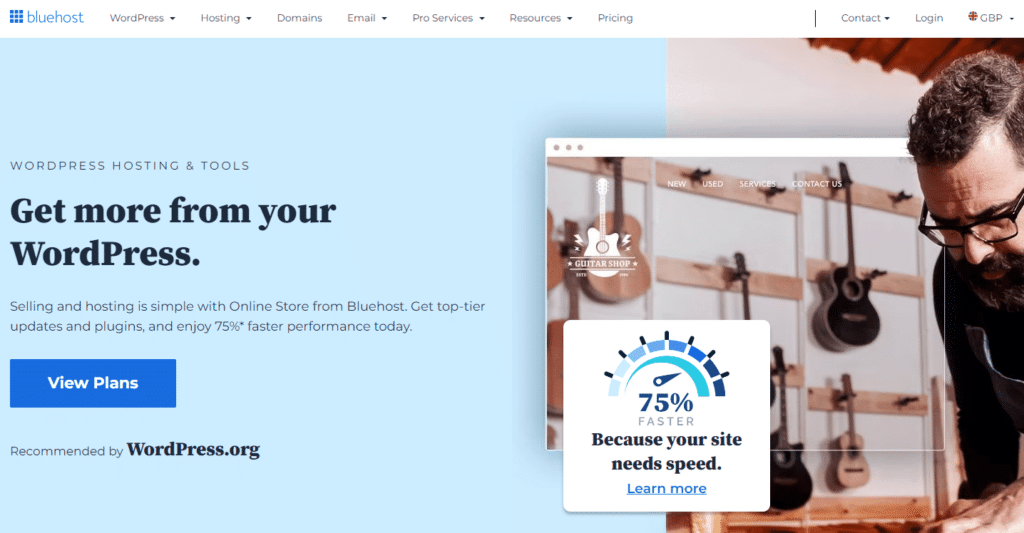
1. High server and hosting costs
A lot of server activity is involved when a user requests your site.
The server pulls the requested information from the database and sends it back to the user in a way that fits their input, location, and preferences. This happens in real time for every visitor.
The more the number of site visitors who request your site, the higher the load on your server intensifies. You’ll need more powerful server resources to process database queries and handle backend logic. This way, your server doesn’t get overwhelmed and crash.
Higher hosting fees
Upgrading to new servers is expensive. To ensure your site remains fast, you’ll usually need to move to more expensive hosting plans, such as VPS, cloud hosting, and dedicated servers.
Keep in mind visitors expect websites to load quickly. 53% of users will abandon a site that takes longer than 3 seconds to load.
The shared hosting plan that most new websites start with might not be enough. Most shared plans can only handle a moderate amount of traffic or monthly visits, which is insufficient to run a small site.
Setup fees and site migrations
Setup fees, which occur when providers physically add hardware components, can also result in additional expenses. These fees are more common at the dedicated server level.
If you migrate your website from one hosting provider to another, you might incur a site migration fee.
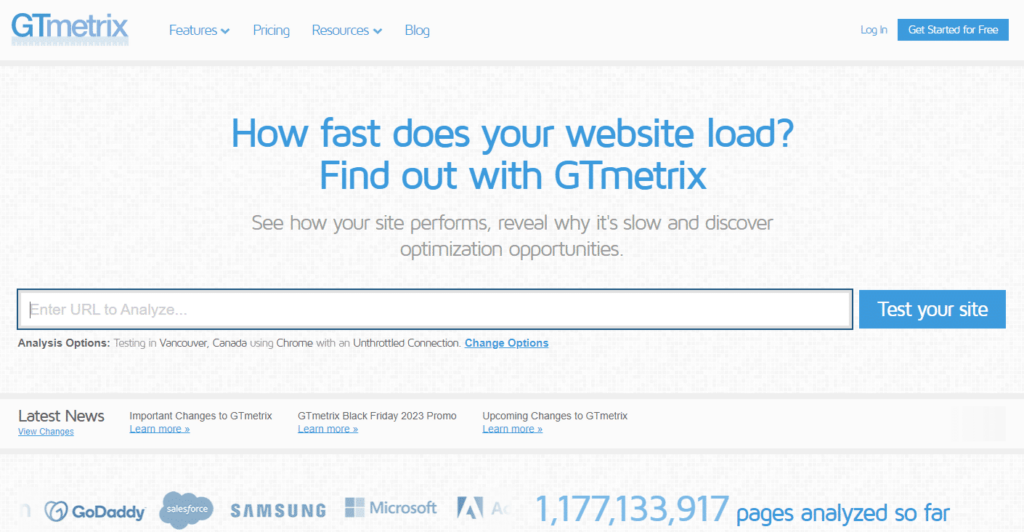
2. Performance bottlenecks
When you have a few visitors, a server only needs milliseconds to generate dynamic web pages and respond to the browser. But as your traffic increases, the server might struggle to handle all requests and slow down.
That’s what a performance bottleneck is. It happens when a server is struggling to process user requests efficiently because of the heavy demand put on it by high traffic.
Dynamic websites generally depend heavily on the server. During high traffic, they are more prone to slowing down, which can ruin the user experience for visitors.
Studies show that even a 1-second delay in page load time can reduce conversions by 11%. So you can’t leave it all to chance.
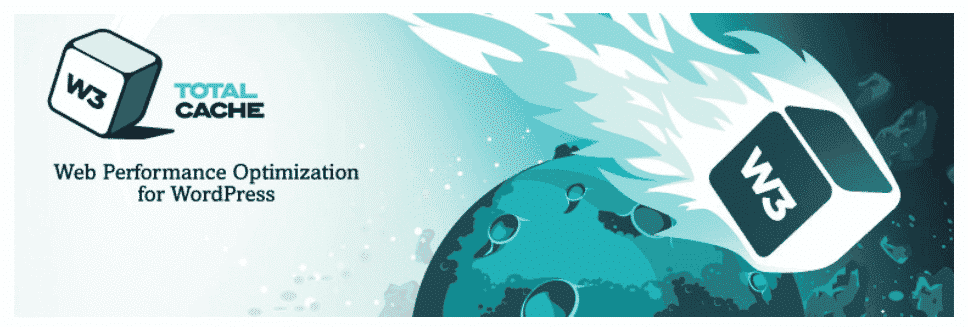
Invest in performance optimization tools
Apart from upgrading to more expensive hosting plans, you’ll often need additional performance optimization tools and services to cope with the increasing traffic.
Some of these tools include:
- Caching plugins (e.g., WP Rocket). These plugins cache dynamic web pages to reduce server load.
- Content Delivery Networks (CDNs) distribute static assets (such as images, CSS, and JS) to servers closer to users.
While these tools are effective, the best ones are usually pricey.
Run fast, secure, and maintenance-free WordPress with Static Studio.
3. Complex maintenance
Dynamic websites also need frequent updates to keep everything running smoothly. This includes updates for the CMS (Content Management System), themes, plugins, and any custom features.
We can’t ignore these updates because they help to:
- Fix bugs.
- Add new features.
- Keep the site secure.
Without regular updates, your site could become vulnerable to cyberattacks. It can also slow performance or result in errors that frustrate users.
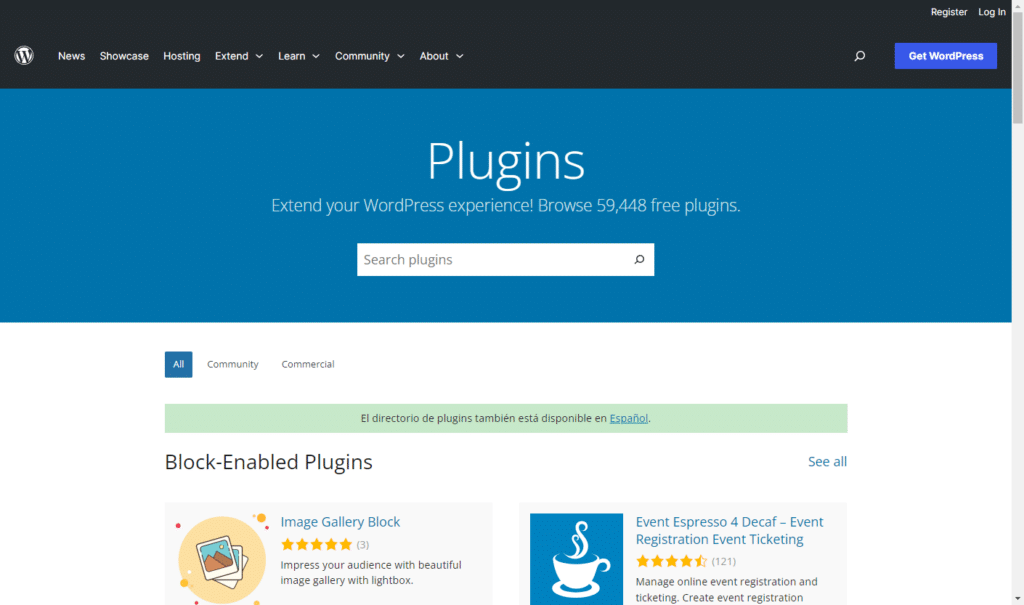
Ongoing maintenance can be costly
The more plugins and tools you use, the more maintenance you’ll need. If you can’t handle it yourself, you’ll have to pay professionals to do it for you. This adds to the operational costs of running a dynamic site. It becomes even more costly if your business uses many custom features or connects to other services.
Failing to invest in regular maintenance can lead to more significant problems. Problems such as downtime or expensive emergency repairs.
Note: Downtime is another indirect cost of web hosting. It isn’t directly billed to the customer, but every time your site goes down due to a server crash or network error, you’ll lose money. Downtimes also damage your reputation and deter potential customers.

4. Increased security risks
The database is the most targeted component of a dynamic website. Since dynamic sites rely heavily on databases to store user information, they are prime attack targets.
Hackers will often try to access the database to steal or alter data. Other common entry points for hackers include server-side code (like PHP) and third-party plugins with vulnerabilities.
A security breach is costly to recover from. According to Statista, the average cost of a data breach globally in 2024 was $4.88 million, and this threat is still on the rise.
Mitigating security risks
Additional security cannot be obtained directly from your web hosting provider. Therefore, investing in premium security tools and monitoring services becomes essential.
Security tools like Sucuri and Wordfence are common expenses. These tools add different security measures to boost your site’s security, such as spam filtering and firewalls.
Plus, hosting providers may also charge extra for dedicated security add-ons like daily backups or advanced DDoS protection.
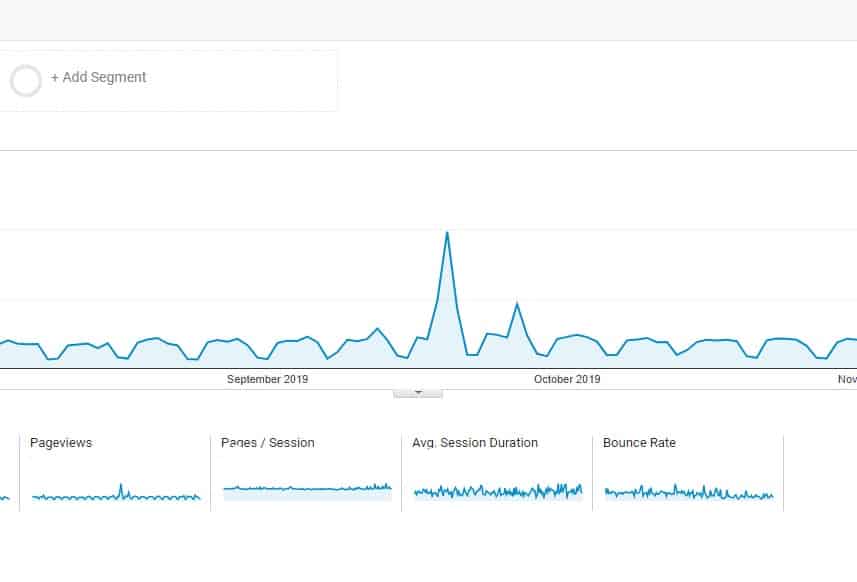
5. Scaling challenges
Running dynamic sites demands more server resources to maintain peak performance when traffic spikes. Usually, every web hosting plan allocates a certain number of resources to your website.
So, which resources are these? They include:
- Bandwidth. Determines how fast your server can transfer data to the user.
- Central processing units. CPUs handle all the user requests and operations on your site.
- Random access memory. RAM acts as short-term memory, allowing your server to process multiple requests simultaneously.
- SSD storage. Refers to the available storage space for your HTML files, databases, and media.
Generally speaking, the more server resources you need, the higher your hosting costs will be.
Scaling doesn’t come cheap
Scaling may also involve other costly infrastructure upgrades to accommodate sustained growth in dynamic sites. For example, you may need to invest in load balancers to distribute traffic across multiple servers and prevent overload.
Or:
- Call providers to add more web servers to handle increased traffic.
- Buy advanced cloud solutions like AWS or Google Cloud. These solutions provide scalable hosting resources but have complex pricing structures that can quickly escalate.

6. Longer web development times
Building, customizing, and updating dynamic sites takes longer than building static sites. Dynamic sites deliver dynamic content through complex backend coding, databases, and integrations with external tools like APIs or plugins.
For example:
- Adding personalized features, like user dashboards or interactive elements, requires detailed coding and testing on both the backend and the front end.
- Integrating advanced tools for ecommerce, SEO, or other web applications often involves compatibility checks and adjustments.
These tasks increase the time needed to launch or update the site. Delays also raise developer costs and slow your ability to adapt quickly to user needs or market changes. Generally, longer development times can affect your overall timeline, budget, and business growth.
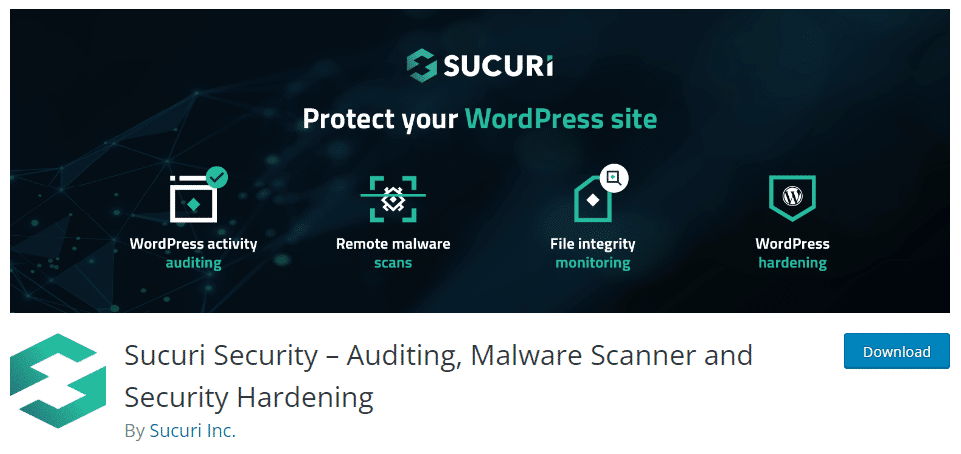
7. Premium add-ons for functionality
Dynamic sites often need premium add-ons to add or improve certain features.
For example, you might realize your current forms aren’t advanced enough for user feedback or lead generation. To solve this, you could add a tool like Gravity Forms for more powerful form-building options.
If your site isn’t ranking well on search engines, a plugin like Rank Math PRO could help improve your SEO strategy. For ecommerce sites, you might notice a lack of options for subscriptions or custom payment methods.
In this case, premium plugins like WooCommerce Subscriptions can fill the gap and enhance your store.
These premium plugins offer added features, better support, and more customization, but they also have extra costs.
Package extras
Not to mention, web hosting also comes with package extras.
Every web hosting provider also tries to sign you up for as many additional services as possible. Navigating through these package extras is just part of shopping for web hosting.
That’s all for the hidden costs in dynamic websites. If you want an effective way to save money, here comes the solution.
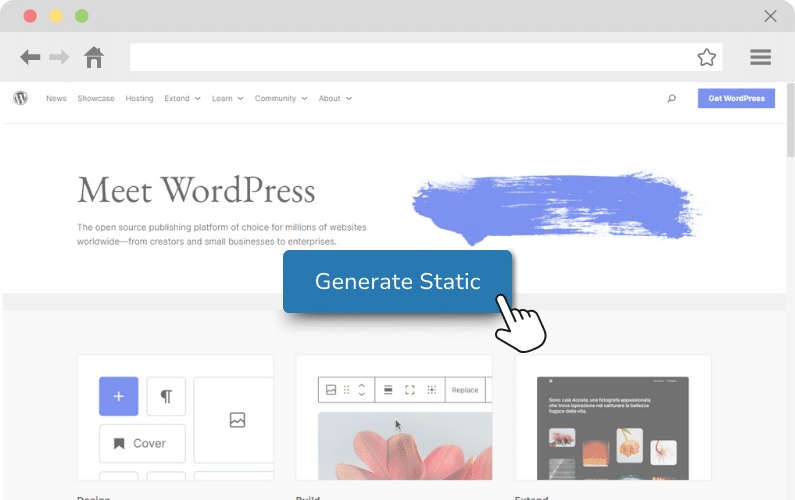
How you can save money with static websites
Dynamic websites cost more to run because they require extra resources for hosting, scaling, maintenance, security, and performance. However, converting a dynamic website to a static site can eliminate these costs and save money.
Static websites are faster, safer, perform better, and are more affordable.
Run fast, secure, and maintenance-free WordPress with Static Studio.
Why converting to a static site saves money
Converting to a static site simplifies its operation by eliminating the need for dynamic processes. Instead of generating content on demand for each visitor, a static site delivers pre-built pages stored on a server or CDN.
This means no databases, complex backend processing, and fewer moving parts. Anyone who opens a static site from anywhere will instantly see the same content. This streamlined setup reduces technical requirements and makes the site easier to manage.
For many, WordPress is the go-to platform for building dynamic websites due to its user-friendly interface and flexibility. However, as your site grows, the costs and challenges of maintaining a dynamic WordPress site can escalate.
That’s where the plugin Simply Static comes in.

Introducing Simply Static
Simply Static is a WordPress plugin that easily converts your existing WordPress website to a static website with the click of a button.
After installing, you’ll be guided through a few adjustments. This typically involves selecting the URL path you want to use in your static files and the pages you want to include or exclude.
Then, this plugin will generate static file copies of all your WordPress pages, blog posts, comments, forms, etc.
The static conversion of your entire WordPress site:
- Enhances its performance.
- Upgrades the site’s security by eliminating database calls.
- Reduce costs of maintenance going forward.
- and more.
Let’s get into it and see how Simply Static saves you time and money on hosting, security, performance, and maintenance.
Run fast, secure, and maintenance-free WordPress with Static Studio.
How Simply Static saves on the hidden costs of dynamic websites
The following are various ways Simply Static saves you time and money compared to their dynamic counterparts.

1. Lower hosting costs
Static files require minimal server resources to deliver content to any web browser. You can host these files for free on platforms like GitHub Pages, Netlify, or Vercel. Even paid options rarely exceed $20/month, which is far lower than the costs of hosting a dynamic site on a VPS or dedicated server.
Other inexpensive options for hosting your static files include cloud storage services like Amazon S3.

How Simply Static helps
Simply Static helps by converting your WordPress site to a static version. Because the final static WordPress site is delinked from the database, it will require far fewer server resources to serve content.
Consequently, this drastically reduces your hosting expenses for the static version.
You can host the resulting static files anywhere, including free or low-cost platforms. However, the host depends on the website, how convenient the setup should be, and the pricing.
We recommend Cloudflare Pages, Netlify, BunnyCDN, and AWS S3. Keep it easy at first and switch when needed.
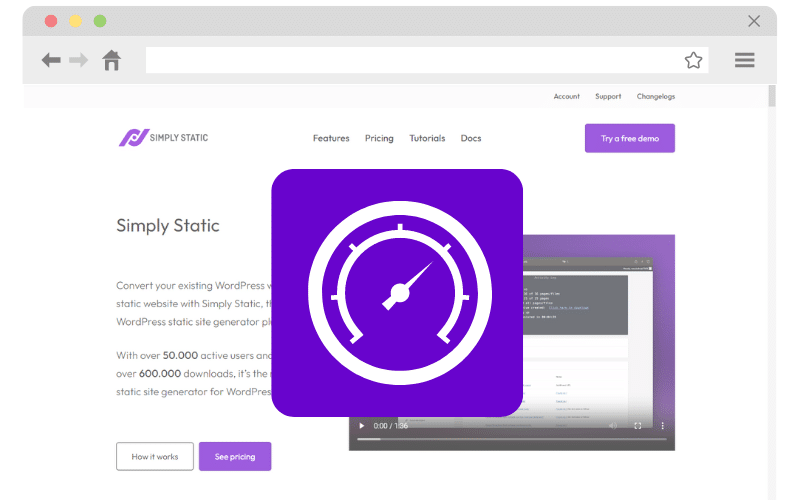
2. No need for expensive performance plugins
Dynamic WordPress sites rely on expensive performance plugins like WP Rocket or NitroPack. These plugins boost page load speeds through techniques like caching, compression, and script optimization to counteract the delays caused by repeated database calls or server processing.
Simply Static eliminates repeated database calls, so you won’t have to pay for these performance plugins any longer.
Your static site is already optimized for performance and speed, which can save you hundreds of dollars annually in plugin costs.
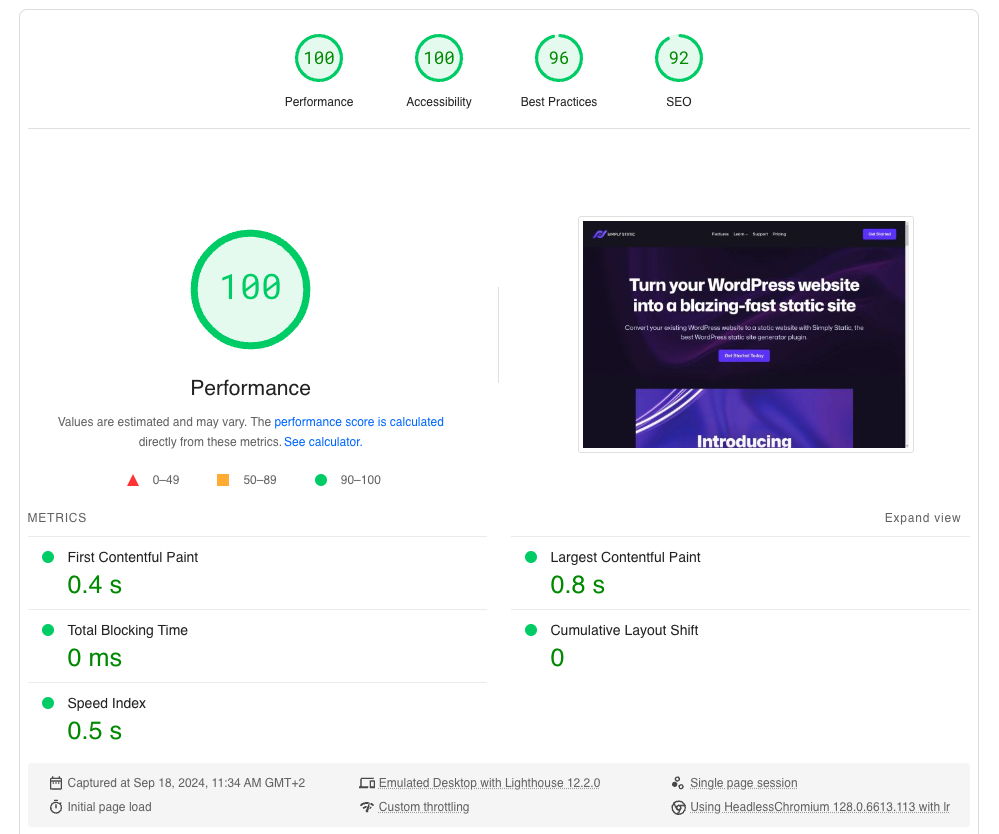
Other ways Simply Static optimizes your site for speed
In addition, this plugin goes the extra mile to include extra features like minification and image optimization. These optimization techniques run automatically in the background as you convert.
- Minification automatically minifies your HTML files (including inline CSS & JS) to ensure your final static site is lightweight.
- Integration with ShortPixel API automatically optimizes images on your static website.
3. Minimal maintenance
Maintaining a dynamic website is far more involved than maintaining a static site. To stay safe, you sometimes have to update several plugins, databases, server-side scripts, and themes.
Run fast, secure, and maintenance-free WordPress with Static Studio.
Static sites, on the other hand, don’t have databases or server-side scripts to update. The static conversion reduces the plugins you need to update in a static environment.
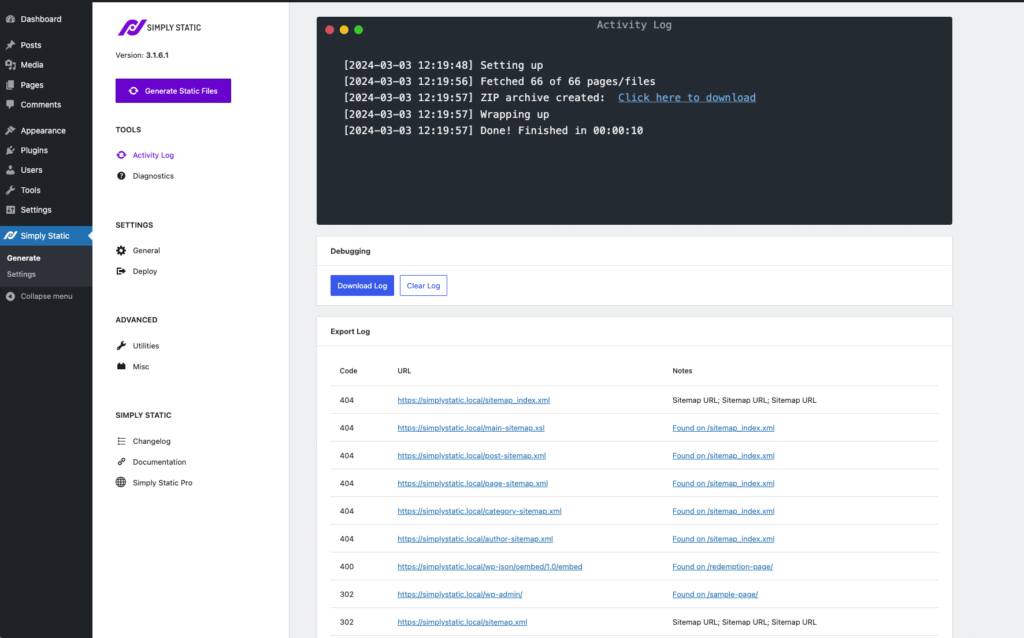
Easy site updates with Simply Static
The original WordPress dashboard is only available to authorized users for updates and changes. You can still use it for content management and a good user experience.
Simply Static will generate and deploy a static version of your site for visitors to see and interact with.
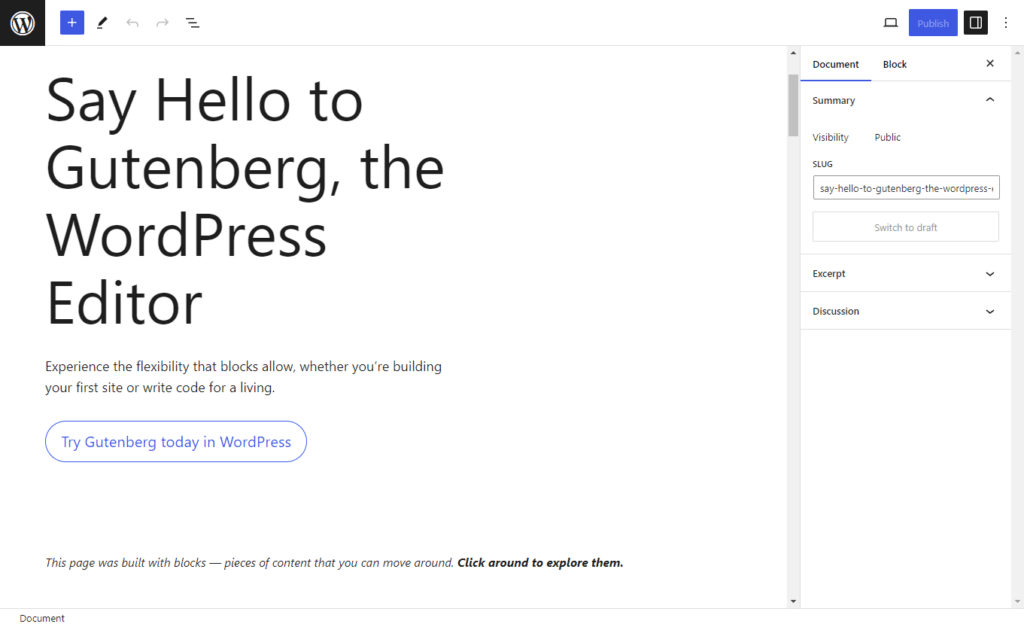
This hybrid approach gives you the best of both worlds:
- Effortless content updates using WordPress’s familiar interface.
- Low-maintenance deployment, as the static version requires no regular updates or backend management.
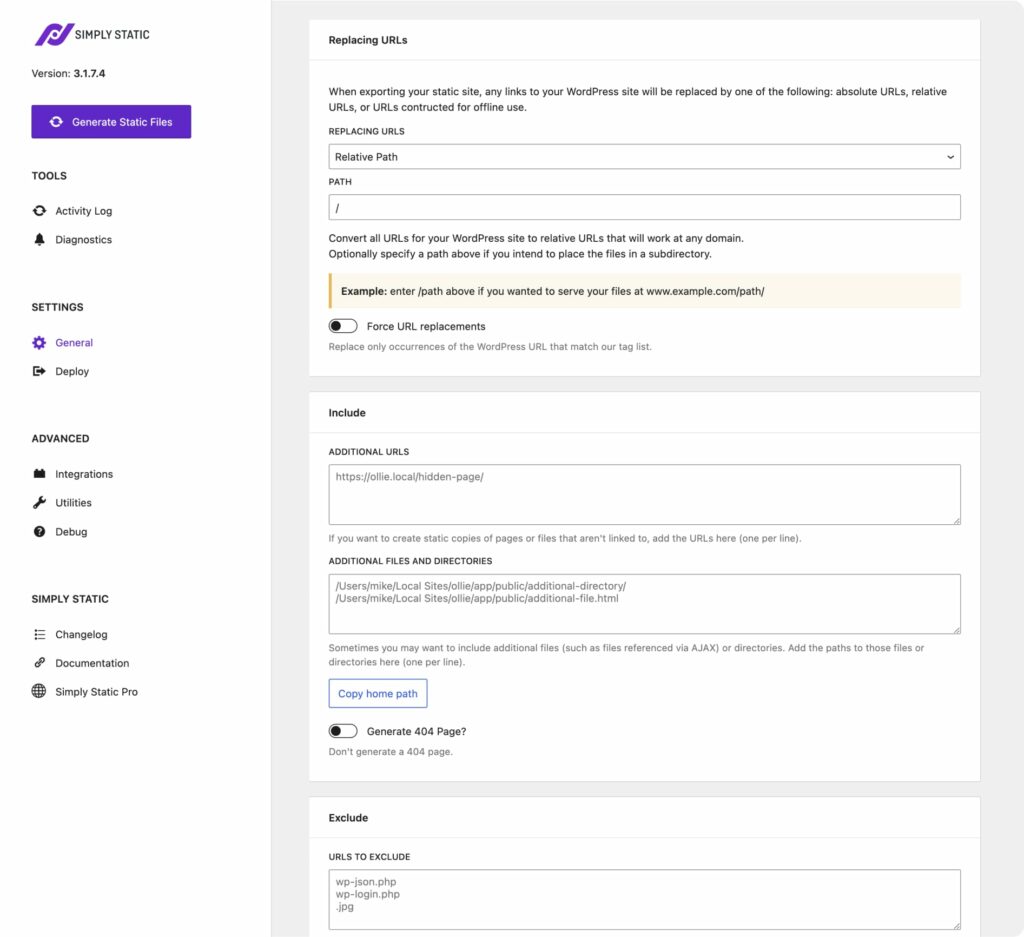
4. Enhanced security without extra tools
Just shopping around for security tools that provide all the security measures to protect a dynamic website alone is expensive.
With Simply Static, you don’t have to shop around for extra security tools. Or incur high costs associated with traditional security measures like spam filtering, malware scans, etc.
How Simply Static helps you save on security costs
When you convert your WordPress site to a static version with Simply Static, it removes most WordPress vulnerabilities. There’s no accessible database to exploit. No dynamic code dependencies for the user-facing site. It hides your WordPress backend.
It removes bulky WordPress features like emojis, Rest API URLs, and WordPress version numbers.
As a result:
- Your static site is immune to database-related attacks like SQL injections.
- Malicious scripts and exploits targeting dynamic code become irrelevant.
- You no longer need premium security tools like Wordfence or Sucuri, saving you potentially hundreds of dollars annually.
The resulting static website has few to zero entry points of attack.

5. Effortless scalability
Simply Static makes scaling static sites much easier via a CDN. Firstly, it generates a static version of your WordPress site that is CDN-ready. So, once your WordPress website is made static, you can deploy it via a CDN (Content Delivery Network) service.
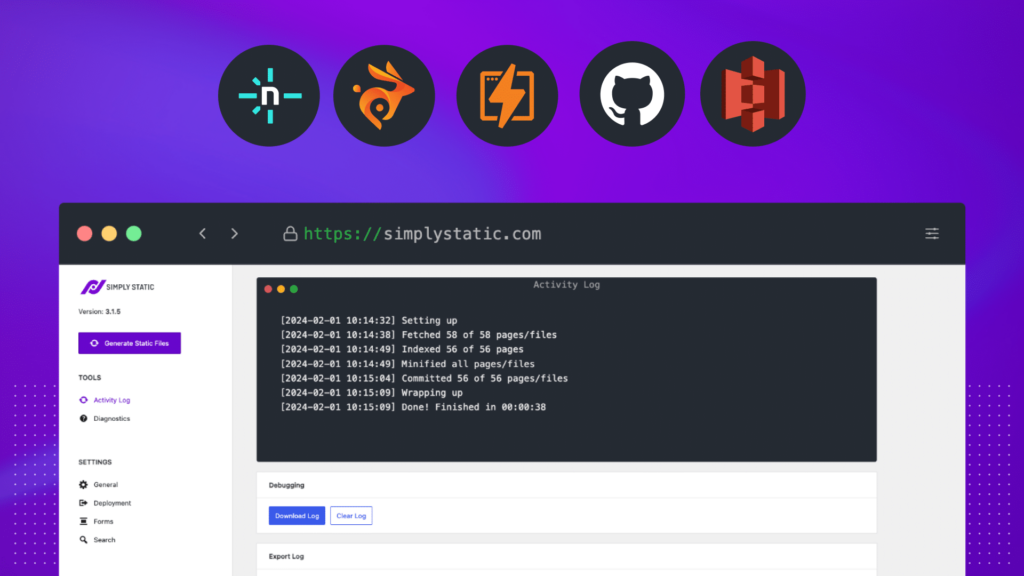
By deploying the static files to a CDN like Cloudflare, SimplyCDN (in-house CDN), BunnyCDN, or AWS, you can:
- Handle sudden traffic surges without worrying about server crashes or high hosting fees.
- Enjoy seamless scalability with little to no extra effort on your part.
- Save on infrastructure costs that would otherwise escalate with a dynamic site.
The benefits of deploying via a CDN
CDNs generally cache and serve static content from servers closest to the user. Thus, users can load your static pages almost instantly, regardless of their location. CDNs ensure fast page loads while using minimal resources, even during high-traffic periods.
A CDN can efficiently handle traffic spikes, which explains why costly infrastructure upgrades are unnecessary.
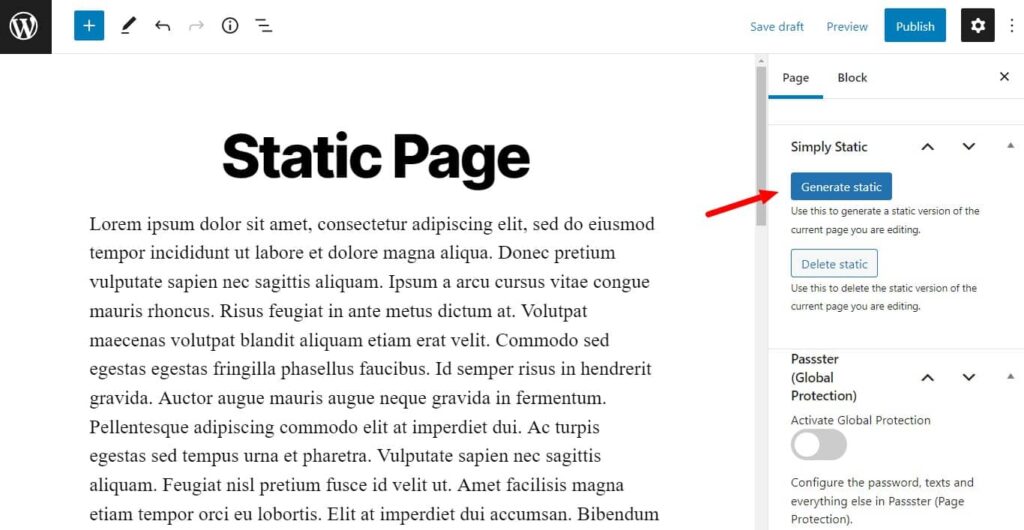
6. Faster development and deployment
Static sites are more straightforward to build and deploy than dynamic websites for three main reasons. First, they don’t have backend dependencies, so developers don’t need to configure databases, server-side scripts, or dynamic frameworks.
Tools like Hugo, Jekyll, or Eleventy allow developers to generate static sites quickly using pre-built templates and markdown files. Static files can be uploaded directly to hosting platforms or CDNs without additional setup.
Note: Everyone except those with ecommerce websites (WooCommerce) or membership sites can use Simply Static. However, you can work around this by creating your own ecommerce store on Ecwid.
How Simply Static makes it even easier
Simply Static automatically converts WordPress to a static site. It generates HTML pages for deployment on various platforms.
More importantly, you don’t need advanced technical knowledge. The plugin handles the heavy lifting parts for you, making it accessible even for non-developers.
- You won’t lose any of your SEO optimizations when going with a static WordPress setup.
- We have excellent support for all the big players in the website builder space, such as Elementor.
- Ads injected by tools like Google Adsense or Ezoic will also work the same way as in traditional WordPress.
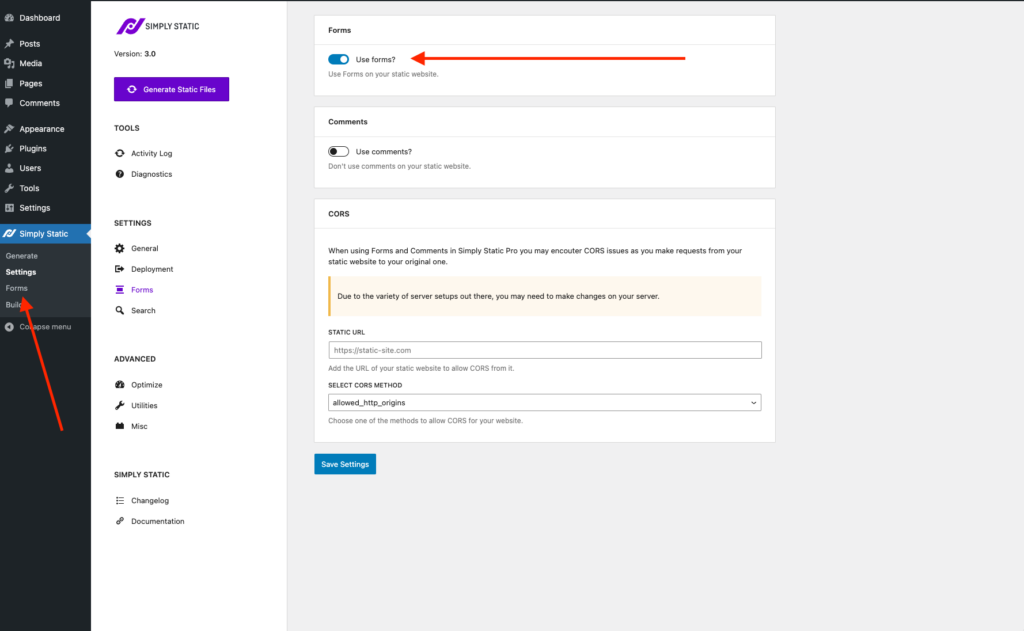
7. No need for premium add-ons
Many functionalities, like forms or search, can be implemented using free or low-cost static alternatives. For example, you can integrate affordable tools like Netlify Forms or Algolia for search.
These are free or affordable static-compatible tools that can replace the expensive plugins you need to pay for advanced features in dynamic WordPress. There are no web hosting package extras that’ll surprise you or indirect costs like downtime.
Simply Static offers built-in search functionality
Simply Static Pro lets you add basic and advanced search capabilities to your website. Basic search uses Fuse.js, which also provides autosuggestions to enhance your user’s search experience.
Advanced search implements Algolia for a more detailed and responsive search experience. This way, users can find your content faster and more accurately.
Understand dynamic websites and their hidden costs
Dynamic websites are helpful because of their extensive functionality and user interactivity. However, running these sites often involves hidden costs such as higher hosting fees, expensive plugins, complex maintenance, and security vulnerabilities.
These unexpected costs can strain your budget and make your site more expensive than it has to be.
Fortunately, you can save on these costs by converting your WordPress site into a static version with Simply Static. It cuts hidden costs by eliminating database calls and WordPress vulnerabilities and reducing the need for expensive plugins.
That means lower expenses, enhanced security, and improved performance without sacrificing WordPress’s ease of use.
Run fast, secure, and maintenance-free WordPress with Static Studio.

